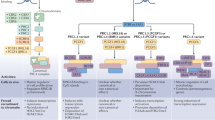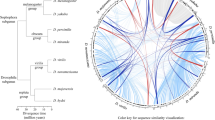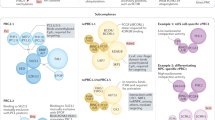Abstract
Polycomb group (PcG) complexes are multiprotein assemblages that bind to chromatin and establish chromatin states leading to epigenetic silencing1,2. PcG proteins regulate homeotic genes in flies and vertebrates, but little is known about other PcG targets and the role of the PcG in development, differentiation and disease. Here, we determined the distribution of the PcG proteins PC, E(Z) and PSC and of trimethylation of histone H3 Lys27 (me3K27) in the D. melanogaster genome. At more than 200 PcG target genes, binding sites for the three PcG proteins colocalize to presumptive Polycomb response elements (PREs). In contrast, H3 me3K27 forms broad domains including the entire transcription unit and regulatory regions. PcG targets are highly enriched in genes encoding transcription factors, but they also include genes coding for receptors, signaling proteins, morphogens and regulators representing all major developmental pathways.
This is a preview of subscription content, access via your institution
Access options
Subscribe to this journal
Receive 12 print issues and online access
$209.00 per year
only $17.42 per issue
Buy this article
- Purchase on Springer Link
- Instant access to full article PDF
Prices may be subject to local taxes which are calculated during checkout






Similar content being viewed by others
References
Pirrotta, V. PcG complexes and chromatin silencing. Curr. Opin. Genet. Dev. 7, 249–258 (1997).
Lund, A.H. & van Lohuizen, M. Polycomb complexes and silencing mechanisms. Curr. Opin. Cell Biol. 16, 239–246 (2004).
Rastelli, L., Chan, C.S. & Pirrotta, V. Related chromosome binding sites for zeste, suppressors of zeste and Polycomb group proteins in Drosophila and their dependence on Enhancer of zeste function. EMBO J. 12, 1513–1522 (1993).
Chan, C.-S., Rastelli, L. & Pirrotta, V. A Polycomb response element in the Ubx gene that determines an epigenetically inherited state of repression. EMBO J. 13, 2553–2564 (1994).
Sengupta, A.K., Kuhrs, A. & Muller, J. General transcriptional silencing by a Polycomb response element in Drosophila. Development 131, 1959–1965 (2004).
Saurin, A.J., Shao, Z., Erdjument-Bromage, H., Tempst, P. & Kingston, R.E. A Drosophila Polycomb group complex includes Zeste and dTAFII proteins. Nature 412, 655–660 (2001).
Czermin, B. et al. Drosophila Enhancer of Zeste/ESC complexes have a histone H3 methyltransferase activity that marks chromosomal Polycomb sites. Cell 111, 185–196 (2002).
Cao, R. et al. Role of histone H3 lysine 27 methylation in Polycomb-group silencing. Science 298, 1039–1043 (2002).
Kuzmichev, A., Nishioka, K., Erdjument-Bromage, H., Tempst, P. & Reinberg, D. Histone methyltransferase activity associated with a human multiprotein complex containing the Enhancer of Zeste protein. Genes Dev. 22, 2893–2905 (2002).
Müller, J. et al. Histone methyltransferase activity of a Drosophila Polycomb Group repressor complex. Cell 111, 197–208 (2002).
Fischle, W. et al. Molecular basis for the discrimination of repressive methyl-lysine marks in histone H3 by Polycomb and HP1 chromodomains. Genes Dev. 17, 1870–1881 (2003).
Jones, R.S. & Gelbart, W.M. Genetic analysis of the Enhancer of zeste locus and its role in gene regulation in Drosophila melanogaster. Genetics 126, 185–199 (1990).
Phillips, M.D. & Shearn, A. Mutations in polycombeotic, a Drosophila Polycomb-group gene, cause a wide range of maternal and zygotic phenotypes. Genetics 125, 91–101 (1990).
Strutt, H. & Paro, R. The polycomb group protein complex of Drosophila melanogaster has different composition at different target genes. Mol. Cell. Biol. 17, 6773–6783 (1997).
Bloyer, S., Cavalli, G., Brock, H.W. & Dura, J.-M. Identification and characterization of polyhomeotic PREs and TREs. Dev. Biol. 261, 426–442 (2003).
Reim, I., Lee, H.-H. & Frasch, M. The T-box-encoding Dorsocross genes function in amnioserosa development and the patterning of the dorsolateral germ band downstream of Dpp. Development 130, 3187–3204 (2003).
Jagla, K., Bellard, M. & Frasch, M. A cluster of Drosophila homeobox genes involved in mesoderm differentiation programs. Bioessays 23, 125–133 (2001).
Chiang, A., O'Connor, M.B., Paro, R., Simon, J. & Bender, W. Discrete Polycomb-binding sites in each parasegmental domain of the bithorax complex. Development 121, 1681–1689 (1995).
Shimell, M.J., Peterson, A.J., Burr, J., Simon, J.A. & O'Connor, M. Functional analysis of repressor binding sites in the iab-2 regulatory region of the abdominal-A homeotic gene. Dev. Biol. 218, 38–52 (2000).
Busturia, A., Wightman, C.D. & Sakonju, S. A silencer is required for maintenance of transcriptional repression throughout Drosophila development. Development 124, 4343–4350 (1997).
Mihaly, J., Hogga, I., Gausz, J., Gyurkovics, H. & Karch, F. In situ dissection of the Fab-7 region of the bithorax complex into a chromatin domain boundary and a Polycomb-response element. Development 124, 1809–1820 (1997).
Barges, S. et al. The Fab-8 boundary defines the distal limit of the bithorax complex iab-7 domain and insulates iab-7 from initiation elements and a PRE in the adjacent iab-8 domain. Development 127, 779–790 (2000).
Orlando, V. & Paro, R. Mapping Polycomb-repressed domains in the bithorax complex using in vivo formaldehyde cross-linked chromatin. Cell 75, 1187–1198 (1993).
Gene Ontology Consortium. The Gene Ontology (GO) database and informatics resource. Nucleic Acids Res. 32, D258–D261 (2004).
Ringrose, L., Rehmsmeier, M., Dura, J.M. & Paro, R. Genome-wide prediction of Polycomb/Trithorax response elements in Drosophila melanogaster. Dev. Cell 5, 759–771 (2003).
Brunk, B.P., Martin, E.C. & Adler, P.N. Drosophila genes Posterior Sex Combs and Suppressor two of zeste encode proteins with homology to the murine bmi-1 oncogene. Nature 353, 351–353 (1991).
Lee, T.I. et al. Control of developmental regulators by Polycomb in human embryonic stem cells. Cell 125, 301–313 (2006).
Bernstein, B.E. et al. A bivalent chromatin structure marks key developmental genes in embryonic stem cells. Cell 125, 315–326 (2006).
Négre, N. et al. Chromosomal distribution of PcG proteins during Drosophila development. PLoS Biol. 4, e170 (2006).
Schneider, I. Cell lines derived from the late embryonic stages of Drosophila melanogaster. J. Embryol. Exp. Morphol. 27, 353–356 (1972).
Acknowledgements
We are grateful to T. Jenuwein for the anti-H3 me3K27 antibody; to D. McCabe for polytene chromosome preparations; to A. Brooks, Q. Wang and V. Patel of the Bionomics Research and Technology Center of the Rutgers Environmental and Occupational Health Sciences Institute for hybridization and scanning of the microarrays. Particular thanks to M. Eisen for leading the Berkeley Drosophila Transcription Network Project's development of ChIP/chip data analysis methods and for encouraging this work. Work conducted by the BDTNP is funded by a grant from the US National Institute of General Medical Sciences and the US National Human Genome Research Institute (GM704403) at Lawrence Berkeley National Laboratory under Department of Energy contract DE-AC02-05CH11231.
Author information
Authors and Affiliations
Corresponding author
Ethics declarations
Competing interests
D.A.N. is employed by Affymetrix.
Supplementary information
Supplementary Fig. 1
Distribution of PcG proteins and H3 me3K27 mark along the X chromosome. (PDF 81 kb)
Supplementary Fig. 2
Distribution of PcG proteins and H3 me3K27 mark along chromosome 4. (PDF 84 kb)
Supplementary Fig. 3
Distribution of PcG proteins and H3 me3K27 mark along 2L chromosome. (PDF 83 kb)
Supplementary Fig. 4
Distribution of PcG proteins and H3 me3K27 mark along 2R chromosome. (PDF 81 kb)
Supplementary Fig. 5
Distribution of PcG proteins and H3 me3K27 mark along 3L chromosome. (PDF 82 kb)
Supplementary Fig. 6
Co-localization between the binding of PSC and other PcG proteins. (PDF 44 kb)
Supplementary Fig. 7
Co-localization between the binding of E(Z) and other PcG proteins. (PDF 42 kb)
Supplementary Fig. 8
Comparison of microarray data to the Ringrose et al. genome-wide prediction of PREs. (PDF 21 kb)
Supplementary Fig. 9
PcG proteins bind to ph and Psc-Su(z)2 polycomb group genes. (PDF 129 kb)
Supplementary Fig. 10
Valication of microarray hybridization results by real-time PCR. (PDF 207 kb)
Supplementary Table 1
List of PcG sites. (PDF 196 kb)
Supplementary Table 2
General features of PcG sites. (PDF 53 kb)
Supplementary Table 3
List of PCR primers. (PDF 69 kb)
Rights and permissions
About this article
Cite this article
Schwartz, Y., Kahn, T., Nix, D. et al. Genome-wide analysis of Polycomb targets in Drosophila melanogaster. Nat Genet 38, 700–705 (2006). https://doi.org/10.1038/ng1817
Received:
Accepted:
Published:
Issue Date:
DOI: https://doi.org/10.1038/ng1817
This article is cited by
-
DMRscaler: a scale-aware method to identify regions of differential DNA methylation spanning basepair to multi-megabase features
BMC Bioinformatics (2022)
-
Enhancer of trithorax/polycomb, Corto, regulates timing of hunchback gene relocation and competence in Drosophila neuroblasts
Neural Development (2022)
-
Context-specific Polycomb mechanisms in development
Nature Reviews Genetics (2022)
-
Comparative interactome analysis of the PRE DNA-binding factors: purification of the Combgap-, Zeste-, Psq-, and Adf1-associated proteins
Cellular and Molecular Life Sciences (2022)
-
PRC2: an epigenetic multiprotein complex with a key role in the development of rhabdomyosarcoma carcinogenesis
Clinical Epigenetics (2021)



